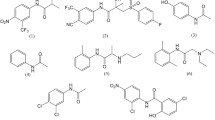Abstract
The in vitro biotransformations of acrylamide and ten related compounds in the hepatic enzyme system of the mouse were studied in order to learn more about their toxic actions in vivo. Of nine analogues, which could be analyzed quantitatively by gas chromatography, seven compounds — N-tert-butylacrylamide, diacetone acrylamide, N,N-dimethylacrylamide, N-isobutoxymethylacrylamide, N-isopropylacrylamide, methacrylamide, and N-methylacrylamide — were metabolized in microsomal enzymes with a NADPH generating system. One or two metabolites from each of the seven compounds, except for N-isobutoxymethylacrylamide, were detected by gas chromatography. The metabolite of N-isopropylacrylamide was identified as acrylamide by gas chromatography-mass spectrometry. The metabolite of N,N-dimethylacrylamide showed a RT value identical with and a mass spectrum similar to N-methylacrylamide. No metabolites from the other four compounds have yet been identified. Acrylamide and crotonamide did not seem to be metabolized in the same system. Phenobarbital pretreatment of mice enhanced the metabolic reactions of the seven compounds, but did not elevate those of acrylamide and crotonamide. The Km value of N-isopropylacrylamide was 0.35 mM, which was the smallest of all the test analogues. All of the eleven analogues studied were found to be metabolized by hepatic glutathione S-transferases as well. This reaction was also elevated by the phenobarbital treatment of mice. The relationships between the in vitro metabolisms and the in vivo toxicities of acrylamide analogues are discussed.
Similar content being viewed by others
References
Boyland E, Chasseaud LF (1967) Enzyme-catalyzed conjugations of glutathione with unsaturated compounds. Biochem J 104: 95–102
Boyland E, Chasseaud LF (1969) Glutathione S-aralkyl-transferase. Biochem J 115: 985–991
Chasseaud LF (1973) Distribution of enzymes that catalyse reactions of glutathione with αβ-unsaturated compounds. Biochem J 131: 765–769
Chasseaud LF (1979) The role of glutathione and glutathione S-transferases in the metabolism of chemical carcinogens and other electrophilic agents. Adv Cancer Res 29: 175–274
Edwards PM (1975) The distribution and metabolism of acrylamide and its neurotoxic analogues in rats. Biochem Pharmacol 24: 1277–1282
Ellman GL (1959) Tissue sulfhydryl groups. Arch Biochem Biophys 82: 70–77
Hashimoto K, Aldridge WN (1970) Biochemical studies on acrylamide, a neurotoxic agent. Biochem Pharmacol 19: 2591–2604
Hashimoto K, Sakamoto J, Tanii H (1981) Neurotoxicity of acrylamide and related compounds and their effects on male gonad in mice. Arch Toxicol (Berl) (in press)
Kaplan ML, Murphy SD, Gilles FH (1973) Modification of acrylamide neuropathy in rats by selected factors. Toxicol Appl Pharmacol 24: 564–579
Kulkarni AP, Fabacher DL, Hodgson E (1978) Induction of hepatic xenobiotic metabolizing enzymes by pesticides. II: Glutathione S-transferase. Toxicol Appl Pharmacol 45: 321
Langvardt PW, Putzig CL, Young JD, Braun WH (1979) Isolation and identification of urinary metabolites of vinyl-type compounds: application to metabolites of acrylonitrile and acrylamide. Toxicol Appl Pharmacol 48: A 161
Lowry OH, Rosebrough NJ, Farr AL, Randall RJ (1951) Protein measurement with the Folin phenol reagent. J Biol Chem 193: 265–275
Mukhtar H, Bresnick E (1976) Mouse liver and lung glutathione S-epoxide transferase: Effects of phenobarbitar and 3-methylcholanthrene administration. Chem Biol Interact 15: 59–67
Author information
Authors and Affiliations
Rights and permissions
About this article
Cite this article
Tanii, H., Hashimoto, K. Studies on in vitro metabolism of acrylamide and related compounds. Arch Toxicol 48, 157–166 (1981). https://doi.org/10.1007/BF00310484
Received:
Issue Date:
DOI: https://doi.org/10.1007/BF00310484
Key words
- Acrylamide analogues
- Acrylamide
- N-tert-Butylacrylamide
- Crotonamide
- Diacetone acrylamide
- N,N-Diethylacrylamide
- N,N-Dimethylacrylamide
- N-Hydroxymethylacrylamide
- N-Isobutoxymethylacrylamide
- N-Isopropylacrylamide
- Methacrylamide
- N-Methylacrylamide
- Mouse hepatic microsomal enzymes
- Glutathione
- S-transferases
- Metabolism
- Conjugation
- Induction by phenobarbital




